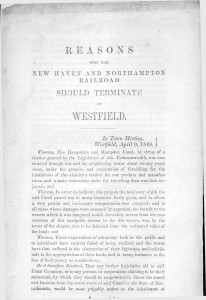 [Posted by Brent Bette for AMST 838: America Collects Itself: From Colony to Empire]
[Posted by Brent Bette for AMST 838: America Collects Itself: From Colony to Empire]
With the warm weather and sweet smell of green grass in the air, one of my favorite “rites of spring” is to take a walk on the well-known Farmington Canal Trail. The path is long and straight with very little in the way of hills, making it ideal for the long-distance runner or the young ‘un who wishes to cast off his or her training wheels. However, I often wonder how many people actually know why such a walk exists? Where would I find my answer? At the Watkinson, of course!
The New Haven and North Hampton Railroad was built alongside the original 78-mile Farmington Canal. In 1836 a Southport man by the name of Joseph Sheffield became the primary stockholder. Realizing canals were far less efficient than railroads, Sheffield hired Professor Alexander Twining of Yale to survey the line from New Haven to Plainville. What Twining found was that the paths created for the animals to tow the barges up and down the canal were an ideal roadbed on which to lay tracks. However, the question remained, what would be the northern terminus of the railroad?
In the towns of western Massachusetts, where politicians and businessmen alike realized the construction of a railroad would yield instantaneous prosperity (and perhaps reelection!), a flurry of lobbying began. Westfield was no exception. On April 9, 1849, the town held a meeting where a resolution was passed stating two points. First, the town publicly acknowledged the suffering of its citizens who made sacrifices (giving up land, etc) to allow for the building of the canal. Unfortunately, the canal never produced the type of economic prosperity promised by the company, leaving Westfield with nothing more than an artificial river. Therefore, restitution needed to be made in the form of a railroad. The resolution further states “that while construction of the proposed Railroad to Springfield could add little or nothing to the prosperity or business of that town…the Legislature, whenever it is possible, [should] encourage the establishment and growth of other such centres of activity and business.” In other words, Springfield already received their share; it was time to spread the wealth.
The pamphlet goes on to explain that a letter had been received from Mr. Sheffield in which he remarked, “We are pleased to learn that you are awake on the subject of Railroad extension.” The town was then asked to provide the amount of tonnage local industry could provide year-to-year. This was seen as an obvious positive sign that Westfield could indeed become the northern terminus of the railroad. However, as was typical of railroad tycoons (often known as robber barons) of the late 19th century, Sheffield was stacking the deck. The data provided by the town was used as a means to determine which would be most profitable for the company. Towns throughout central Massachusetts, whether they knew it or not, were being pitted against one another as a means of getting the “best deal” for the railroad.
Westfield, perhaps due to this resolution, did in fact get its railroad. However, it would not be the northern terminus. Northampton was chosen instead as it would interchange with the Troy and Greenfield railroad. In 1887, the New York, New Haven and Hartford railroad began leasing the line and would eventually purchase it outright.
You can still travel on the New Haven and Northampton railroad, albeit only on foot (or bike). Great progress has been made to convert it to a rail-to-trail, with 72% complete in Connecticut and 47% in Massachusetts. So, the next time you are out enjoying the trail, impressing your companions with your knowledge of historic facts about the line, be sure to say, “And I found it all out at the Watkinson!”